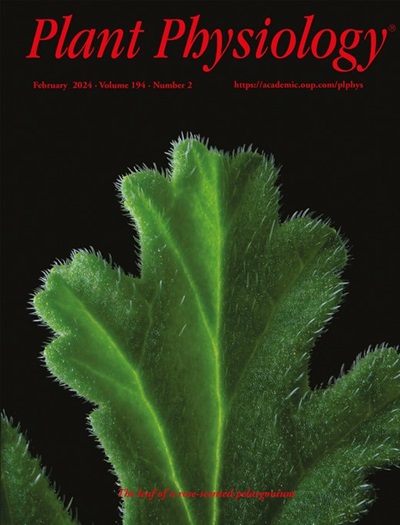The thylakoid membrane remodeling protein VIPP1 forms bundled oligomers in tobacco chloroplasts
IF 6.5
1区 生物学
Q1 PLANT SCIENCES
引用次数: 0
Abstract
The thylakoid membrane (TM) serves as the scaffold for oxygen-evolving photosynthesis, hosting the protein complexes responsible for the light reactions and ATP synthesis. Vesicle Inducing Protein in Plastid 1 (VIPP1), a key protein in TM remodeling, has been recognized as essential for TM homeostasis. In vitro studies of cyanobacterial VIPP1 demonstrated its ability to form large homo-oligomers (> 2 MDa) manifesting as ring-like or filament-like assemblies associated with membranes. Similarly, VIPP1 in Chlamydomonas reinhardtii assembles into rods that encapsulate liposomes or into stacked spiral structures. However, the nature of VIPP1 assemblies in chloroplasts, particularly in Arabidopsis, remains uncharacterized. Here, we expressed Arabidopsis thaliana VIPP1 fused to GFP (AtVIPP1-GFP) in tobacco (Nicotiana tabacum) chloroplasts and performed transmission electron microscopy (TEM). A purified AtVIPP1-GFP fraction was enriched with long filamentous tubule-like structures. Detailed TEM observations of chloroplasts in fixed resin-embedded tissues identified VIPP1 assemblies in situ that appeared to colocalize with GFP fluorescence. Electron tomography demonstrated that the AtVIPP1 oligomers consisted of bundled filaments near membranes, some of which appeared connected to the TM or inner chloroplast envelope at their contact sites. The observed bundles were never detected in wild-type Arabidopsis but were observed in Arabidopsis vipp1 mutants expressing AtVIPP1-GFP. Taken together, we propose that the bundled filaments are the dominant AtVIPP1 oligomers that represent its static state in vivo.类木质膜(TM)是氧进化光合作用的支架,承载着负责光反应和 ATP 合成的蛋白质复合物。质体中的囊泡诱导蛋白 1(VIPP1)是 TM 重塑过程中的一个关键蛋白,被认为对 TM 的平衡至关重要。对蓝藻 VIPP1 的体外研究表明,它能够形成大的同质异构体(> 2 MDa),表现为与膜相关的环状或丝状集合体。同样,莱茵衣藻中的 VIPP1 也组装成包裹脂质体的棒状或堆叠的螺旋状结构。然而,叶绿体(尤其是拟南芥)中 VIPP1 组装的性质仍未确定。在这里,我们在烟草叶绿体中表达了拟南芥 VIPP1 与 GFP 融合(AtVIPP1-GFP),并进行了透射电子显微镜(TEM)观察。纯化的 AtVIPP1-GFP 部分富含长丝管状结构。对固定的树脂包埋组织中的叶绿体进行了详细的 TEM 观察,发现原位的 VIPP1 组合似乎与 GFP 荧光共聚焦。电子断层扫描显示,AtVIPP1 寡聚体由膜附近的束状细丝组成,其中一些细丝在接触部位似乎与 TM 或叶绿体内包膜相连。在野生型拟南芥中从未检测到所观察到的束,但在表达 AtVIPP1-GFP 的拟南芥 vipp1 突变体中却观察到了。综上所述,我们认为束状细丝是 AtVIPP1 的主要寡聚体,代表了其在体内的静止状态。
本文章由计算机程序翻译,如有差异,请以英文原文为准。
求助全文
约1分钟内获得全文
求助全文
来源期刊

Plant Physiology
生物-植物科学
CiteScore
12.20
自引率
5.40%
发文量
535
审稿时长
2.3 months
期刊介绍:
Plant Physiology® is a distinguished and highly respected journal with a rich history dating back to its establishment in 1926. It stands as a leading international publication in the field of plant biology, covering a comprehensive range of topics from the molecular and structural aspects of plant life to systems biology and ecophysiology. Recognized as the most highly cited journal in plant sciences, Plant Physiology® is a testament to its commitment to excellence and the dissemination of groundbreaking research.
As the official publication of the American Society of Plant Biologists, Plant Physiology® upholds rigorous peer-review standards, ensuring that the scientific community receives the highest quality research. The journal releases 12 issues annually, providing a steady stream of new findings and insights to its readership.
 求助内容:
求助内容: 应助结果提醒方式:
应助结果提醒方式:


